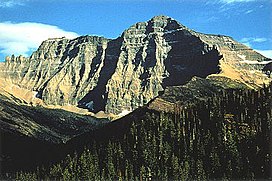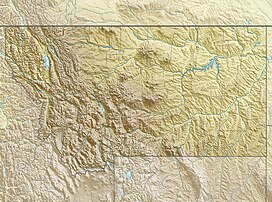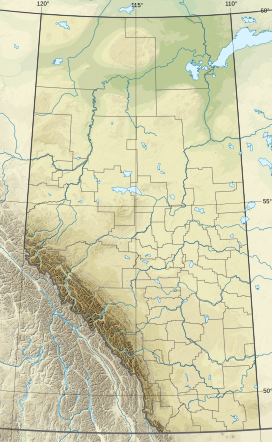Lewis Range
This article needs additional citations for verification. (January 2016) |
| Lewis Range | |
|---|---|
 Mt. Cleveland is the highest peak in the Lewis Range | |
| Highest point | |
| Peak | Mount Cleveland, Montana |
| Elevation | 10,479 ft (3,194 m)[1] |
| Listing | |
| Coordinates | 48°55′29″N 113°50′53″W / 48.92472°N 113.84806°W[1] |
| Geography | |
| Countries | United States and Canada |
| Province/State | Montana and Alberta |
| Parent range | Border Ranges[2] |
| Geology | |
| Orogeny | Lewis Overthrust |
The Lewis Range is a mountain range located in the Rocky Mountains of northern Montana, United States and extreme southern Alberta, Canada. It was formed as a result of the Lewis Overthrust, a geologic thrust fault resulted in the overlying of younger Cretaceous rocks by older Proterozoic rocks. The range is located within Waterton Lakes National Park in Alberta, Canada and Glacier National Park and the Bob Marshall Wilderness Complex in Montana, United States. The highest peak is Mount Cleveland at 10,479 ft (3,194 m).
Geography
[edit]The Lewis Range is within Waterton Lakes National Park in Canada, and in Glacier National Park and the Bob Marshall Wilderness Complex located in Flathead and Lewis and Clark National Forests in Montana. The Continental Divide spans much of the uppermost sections of the range. Major peaks in the range include Mount Cleveland (10,479 ft; 3,194 m), which is the highest peak in the range and in Glacier National Park. Other prominent peaks include Mount Stimson (10,142 ft; 3,091 m), Mount Jackson (10,052 ft; 3,064 m), Mount Siyeh (10,014 ft; 3,052 m), Going to the Sun Mountain, (9,642 ft; 2,939 m) and the isolated Chief Mountain (9,080 ft; 2,770 m). The Chinese Wall in the Bob Marshall Wilderness is a 1,000 ft (300 m) high feature that runs for 40 miles (64 km). Major passes include Marias Pass and Logan Pass which bisects Glacier National Park east to west.
Geology
[edit]Formed by the Lewis Overthrust beginning 170 million years ago, an enormous slab of Precambrian rocks 3 miles (4.8 km) thick, 50 miles (80 km) wide and 160 miles (260 km) long faulted and slid over newer rocks of the Cretaceous period. In this relatively rare occurrence, older rocks are now positioned above newer ones.[citation needed]
See also
[edit]References
[edit]- ^ a b "Cleveland". NGS Data Sheet. National Geodetic Survey, National Oceanic and Atmospheric Administration, United States Department of Commerce. Retrieved 2023-06-07.
- ^ Holland, Stuart S. (1976). Landforms of British Columbia: A Physiographic Outline (PDF) (Report). Government of British Columbia. pp. 84, 85. ASIN B0006EB676. OCLC 601782234. Archived from the original (PDF) on 2018-11-14.
External links
[edit]- Glacier National Park. "Lewis Overthrust Fault". Geology. Retrieved 2023-06-07.
 Media related to Lewis Range at Wikimedia Commons
Media related to Lewis Range at Wikimedia Commons




